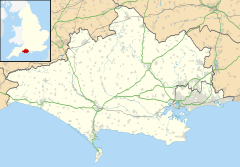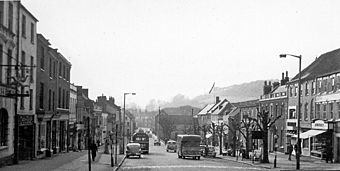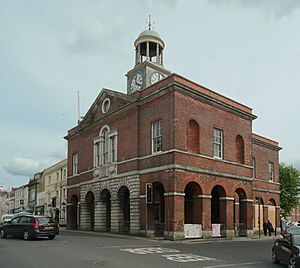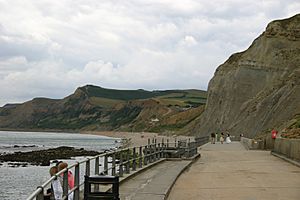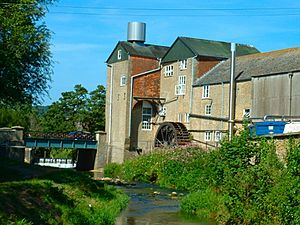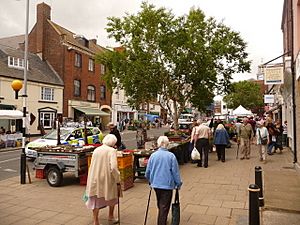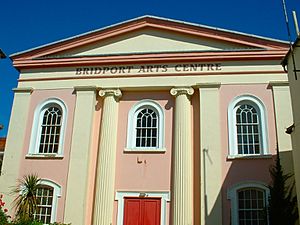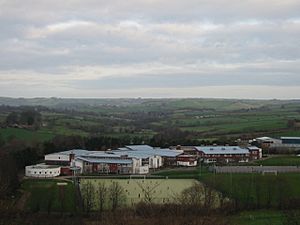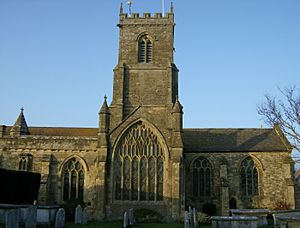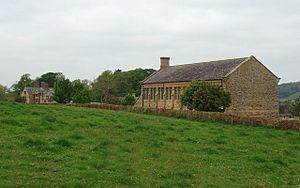Bridport facts for kids
Quick facts for kids Bridport |
|
|---|---|
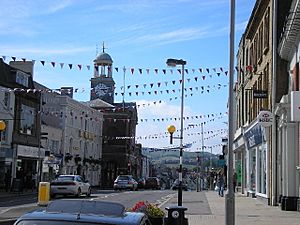 East Street and Bridport Town Hall |
|
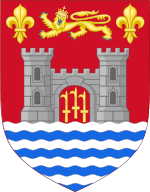 Coat of arms of Bridport |
|
| Population | 13,569 |
| OS grid reference | SY464925 |
| Civil parish |
|
| Unitary authority |
|
| Ceremonial county | |
| Region | |
| Country | England |
| Sovereign state | United Kingdom |
| Post town | BRIDPORT |
| Postcode district | DT6 |
| Dialling code | 01308 |
| Police | Dorset |
| Fire | Dorset |
| Ambulance | South Western |
| EU Parliament | South West England |
| UK Parliament |
|
| Website | https://www.bridport-tc.gov.uk |
Bridport is a busy market town in Dorset, England. It is about 2.4 kilometers (1.5 miles) from the English Channel. The town is located where the River Brit and its smaller river, the Asker, meet.
Bridport has a long history, dating back to Saxon times. It has been famous for making rope for many centuries. Close to the town, on the coast, is West Bay. This is a small fishing harbour, also called Bridport Harbour.
The town is known as Port Bredy in the famous Thomas Hardy novels. Today, Bridport has a lively arts scene. It has an arts centre, a theatre, a cinema, and a museum. In 2011, about 13,568 people lived in Bridport. The town is also twinned with Saint-Vaast-la-Hougue in France.
Contents
History of Bridport
Bridport's story began with the Saxons. During the time of King Alfred, Bridport was one of the four most important places in Dorset. The others were Dorchester, Shaftesbury, and Wareham. Bridport had strong defenses and even its own mint for making coins.
The name Bridport likely comes from a nearby place. In the early 900s, a record called the Burghal Hidage mentioned a fortified town called 'Brydian'. This name probably meant 'place at the River Bride'. It might have referred to an older town in the Bride Valley. Later, the town gave its name to the river it stood on, which became the River Brit.
The Domesday Book of 1086 recorded that Bridport had 120 houses. In 1253, King Henry III gave the town its first special permission, called a charter. Later, under King Edward I, Bridport sent two people to represent it in Parliament.
Challenges in the Middle Ages
In the 1300s and 1400s, Bridport faced tough times. Like other towns along the Dorset coast, it lost many people to the Black Death. One writer said the disease "almost stripped the seaports of Dorset of their inhabitants." During this period, French and Spanish forces also attacked the town.
Bridport's Rope-Making History
Since the Middle Ages, Bridport has been famous for making rope and nets. The first official record of this industry is from 1211. King John ordered Bridport to make "as many ropes for ships both large and small and as many cables as you can."
The materials used to be flax and hemp, grown locally. Today, artificial fibers like nylon are used. Bridport's main street is very wide. This is because it was used to dry the long ropes after they were made. People even used to say "stabbed with a Bridport dagger" to mean someone was hanged. This was because ropes for gallows were made in the town.
English Civil War and Later
During the English Civil War (1642–1651), most people in Bridport supported the Royalists. In 1651, King Charles II briefly stayed at The George Inn. He was trying to escape Parliamentary forces after losing the Battle of Worcester.
Later, in 1685, Bridport saw a small fight during the Duke of Monmouth's Rebellion. Rebel soldiers met local royalist forces here. The rebels retreated, but many local soldiers then joined Monmouth's army.
Many buildings in Bridport, especially on the main street, are from the 1700s. Bridport Town Hall was built in 1785–86. Its clock tower was added about 20 years later. Older buildings include the 13th-century St. Mary's parish church and the 16th-century Bridport Museum.
The Railway Arrives
In 1841, Bridport had 4,787 people. The town did not grow as much as other Dorset towns in the 1800s. However, many strong buildings were built, showing some people were still doing well.
The Bridport Railway opened in 1857. This connected the town to the national train network. It helped the textile industry and brought cheaper goods like coal. In 1884, the line was extended to Bridport Harbour, which was renamed West Bay. This was done to make it a popular holiday spot. The West Bay train line closed to passengers in 1930 and completely in 1962. The entire Bridport line closed in 1975.
Bridport also gave its name to towns in Vermont and Tasmania.
How Bridport is Governed
Bridport has two levels of local government. At the local level, Bridport is a civil parish. It is run by a town council with 20 members. These members are elected from five areas of the town.
At the higher level, Bridport is part of the Dorset unitary authority. The Bridport area elects three members to the Dorset Council.
In 1835, Bridport became a municipal borough. This meant it had its own local government. In 2019, Bridport became part of the larger Dorset unitary authority. On April 1, 2024, the nearby areas of Bothenhampton and Allington officially joined Bridport.
Geography of Bridport
Bridport is in the county of Dorset in South West England. It is about 22.5 kilometers (14 miles) west of Dorchester, the county town. It is also about 2.4 kilometers (1.5 miles) inland from the English Channel at West Bay.
The town centre sits between the small River Brit and its tributary, the Asker. This is about 730 meters (800 yards) north of where they meet. The land here is about 10 to 15 meters (33 to 49 feet) above sea level. Another small river, the River Simene, also joins the Brit west of the town centre.
Bridport's Neighborhoods
Bridport includes several neighborhoods that used to be separate villages. These are places like Allington, Skilling, Coneygar, Bothenhampton, Bradpole, Court Orchard, and St Andrew's Well. South of the town centre is West Bay. This small fishing harbour was known as Bridport Harbour until the railway arrived.
Geology and Natural Beauty
The rocks around Bridport were formed during the Jurassic Period. This was a very long time ago! There are also younger deposits of alluvium (river mud) near the rivers. The coast at Bridport is part of the Jurassic Coast. This is a World Heritage Site that stretches for 154 kilometers (96 miles) along the coast of Dorset and Devon.
The famous Chesil Beach starts at Portland and ends at West Bay. All of Bridport is also within the Dorset National Landscape area. This is a special protected area known for its beautiful scenery. A notable landmark near town is Colmers Hill. It has a unique cone shape and a small group of trees on top.
Population of Bridport
In the 2011 census, Bridport's built-up area had a population of 13,568 people. By 2012, this number was estimated to be 14,697.
| Historic population of Bridport civil parish | ||||||||||||||
|---|---|---|---|---|---|---|---|---|---|---|---|---|---|---|
| Census | 1921 | 1931 | 1951 | 1961 | 1971 | 1981 | 1991 | 2001 | 2011 | |||||
| Population | 5,910 | 5,920 | 6,270 | 6,530 | 6,370 | 6,880 | 7,290 | 7,730 | 8,332 | |||||
| Source:Dorset County Council | ||||||||||||||
In 2014, about 4.8% of homes in Bridport were second homes. This means they were not lived in all year round.
Bridport's Economy
In 1965, writer Ralph Wightman said Bridport was always an "industrial town." He noted its industries were connected to the countryside and the sea. He also said Bridport had avoided major industrial changes and bad economic times. This might be why it was known for good food and drink.
In 2012, 4,900 people worked in Bridport. Most jobs were in shops, hotels, and restaurants (39%). Other important jobs were in public services, education, health (20%), and manufacturing (18%).
Main Businesses and Employers
Many companies in Bridport continue the town's tradition of making rope and nets. Gundry Bridport Ltd makes ropes and nets. AmSafe, which started from Gundry Bridport, makes safety products for planes and defense. Edwards Sports Products, in town since 1884, makes sports nets for big events.
Other companies include Palmer's Brewery and valve-maker Curtiss Wright. Bridport has seven business parks where companies are located.
Bridport has a street market twice a week and a farmers' market once a month. In 2005, there were 128 shops in town. Many well-known national shops are here, like WHSmith, Boots, Morrisons, and Waitrose. R J Balson & Son, a butcher's shop, is thought to be "England's Oldest Family Butchers." They say their family has been butchers since 1515!
West Bay harbour was used by ships carrying timber in the 1970s.
Culture, Art, and Media
In recent years, Bridport's art scene has grown. This has made the town more popular with visitors. It has an arts centre, a theatre, a library, a cinema, and a museum. The town also hosts several events each year.
Arts and Entertainment Venues
Bridport Arts Centre started in the early 1970s. Local people bought an old chapel and schoolroom. They turned them into a theatre and art gallery. The centre offers many cultural events. Since the 1990s, it has received money from the Arts Council. In 1973, the centre started the Bridport Prize. This is an international competition for poetry and short stories.
The Electric Palace Cinema has been in its current spot since 1926. It closed in 1999, but people campaigned to save it. The building was then protected as a listed building. A new owner bought it and made it modern. It reopened in 2007. In 2009, it hosted the world premiere of the movie The Young Victoria.
The Lyric Theatre reopened in 2010. It hosts unique theatre shows, puppet shows, comedy, and music. It is also home to a children's theatre company. Bridport Museum, on South Street, has a large exhibit about the town's long history of rope-making.
Bridport appears as 'Port Bredy' in Thomas Hardy's famous 'Wessex' novels. It is also the setting for other books, like The Spinners by Eden Phillpotts.
Festivals and Events
Bridport hosts many festivals. The Bridport Literary Festival started in 2005. It has featured many famous writers. The Bridport Food Festival is held in late June. It shows off local foods that the area is known for. The Food Festival week ends with a Beer Festival.
Since 2010, there has been an annual Hat Festival in September. An annual Christmas Tree Festival is held in December. Over sixty trees are decorated by local charities.
Bridport has an annual carnival on the third Saturday in August. The main event is a parade with floats and dancers. There are also other fun activities like a car boot sale and a funfair. After the carnival, South Street closes for a street party with live music. The next night, a torchlight procession takes place. 1,500 torches are carried 3.2 kilometers (2 miles) to West Bay for a bonfire and fireworks. These events raise money for local charities.
The Melplash Show is a big agricultural exhibition. It is held every year at West Bay.
Local artists in Bridport open their studios for Bridport Open Studios. This event takes place over three days in August. Over 100 artists take part. The St Michael's Studio complex is a big place for artists. It has studios for 25 artists.
Other events include the West Bay Wallow, a charity swim on Boxing Day. There is also a raft race in the River Brit basin in July. This race is organized by the RNLI. People race in homemade rafts and often wear costumes. It has been running for over 40 years and raises money for the RNLI.
Local Media
Bridport has a local weekly newspaper called the Bridport News. It is published on Thursdays. The Dorset Echo also covers Bridport news.
Bridport receives TV from BBC Spotlight and ITV West Country. Local radio stations include Greatest Hits Radio and BBC Radio Solent. Bridport Radio is a community website that mixes local information with funny made-up news.
Filming Location
Bridport and the area around it have been used for filming many TV shows and movies. These include Hugh Fearnley-Whittingstall's River Cottage and the BBC dramas Harbour Lights and Rockliffe's Folly.
West Bay was used for the 1950s film The Navy Lark. It was also used for the opening credits of The Fall and Rise of Reginald Perrin. Much of the crime drama Broadchurch, starring David Tennant and Olivia Colman, was filmed in West Bay. The writer of Broadchurch, Chris Chibnall, lives in Bridport.
Transport in Bridport
The A35 trunk road goes around the centre of Bridport on a bypass. Other roads starting in town include the A3066, which goes north to Beaminster. The B3157 coast road goes to Weymouth. The busiest road near Bridport is the A35 west of town. In 2012, about 15,200 vehicles used it each day.
Bridport railway station closed in May 1975. The closest train stations are Maiden Newton, Crewkerne, and Dorchester South. There are bus services that connect Bridport to these stations and other towns. In 2017, Dorset County Council stopped funding most rural bus services. So, many nearby villages do not have regular buses.
The closest port with passenger services is Poole. The closest international airports are Exeter and Bournemouth.
Education in Bridport
Bridport has several primary schools. These include Bridport Primary School, St Mary's CE VC Primary School, St Catherine's RC Primary School, and Symondsbury CE VC Primary School.
The Sir John Colfox Academy is the town's only secondary school. It serves students aged 11 to 18. Its sixth form (for older students) is combined with Beaminster School in nearby Beaminster. Some children also go to other secondary schools in the area. These include The Woodroffe School in Lyme Regis and The Thomas Hardye School in Dorchester. Buses run daily to these schools from Bridport.
For further and higher education, students can go to Yeovil College, Weymouth College, Kingston Maurward College, and Bournemouth University.
Religion in Bridport
St Mary's Church was built in the 13th century. Most of it dates from the 15th century. It was repaired and changed a lot in the 1800s. There is a special brass plaque from the 1600s in St. Catherine's Chapel. It remembers Edward Coker, who died in 1685 during the Monmouth Rebellion.
St Mary's Church works closely with the Bridport United Church (Methodist/URC). They hold services, study groups, and children's holiday clubs together. The church can hold up to 400 people and hosts many events. It has eight bells.
Across from the church is a Society of Friends Meeting House. Quakers have been in Bridport since the mid-1600s. George Fox, a founder of Quakerism, visited in 1655. The Bridport Quaker Meeting still meets for worship.
Bridport has a history of nonconformism. This means there were many churches not part of the Church of England. By 1865, there were seven non-Church-of-England churches for every one Anglican church. The Wesleyan chapel on South Street is now the Bridport Arts Centre. It was built in 1838.
The Unitarian "Chapel in the Garden" is on the north side of East Street. It is a place for an open faith community.
Notable Buildings in Bridport
In Bridport and nearby areas, there are 514 buildings that are listed by Historic England. This means they are important for their history or architecture. Three of these are Grade I listed, which is the highest level of importance. These are Bridport Town Hall, the Parish Church of St Mary, and Holy Trinity Old Church in Bothenhampton.
Seventeen buildings are Grade II* listed, meaning they are very important. These include Bridport Museum and The Chantry. The George Inn is from the 15th century. King Charles II stayed there when he was trying to escape to France.
Sports and Leisure in Bridport
Bridport's football club is Bridport F.C., nicknamed "The Bees." They play in the Western Football League Premier Division. The club started in 1885. The town's rugby union club is Bridport RFC.
Bridport & West Dorset Golf Club is on top of the east cliff at West Bay. It has an 18-hole course, a driving range, and a pitch and putt course. Bridport Barracudas Swimming Club is at Bridport Leisure Centre.
The Water Polo section has junior and senior teams. Water Polo matches are held in summer in West Bay's outer harbour. This tradition goes back to 1898. The area also has a real tennis court, one of only 27 in the UK. Hyde court, near Walditch, was renovated in 1998.
Bridport has two bowling clubs. Bridport Bowling Club plays outdoors in summer and indoors in winter. Bridport Indoor Bowling Club plays indoors.
Famous People from Bridport
Many notable people have connections to Bridport. Arthur Lee, 1st Viscount Lee of Fareham and rock musician PJ Harvey were born here. First-class cricketer William Hounsell was also born in Bridport.
American painter John Hubbard lived here in the 1960s and 1970s. Writer Tom Sharpe moved to the town in 1978. Socialist musician Billy Bragg lives nearby in Burton Bradstock. Restaurateur Mark Hix grew up in Bridport. Painter George Biles worked in the town.
See also
 In Spanish: Bridport para niños
In Spanish: Bridport para niños


